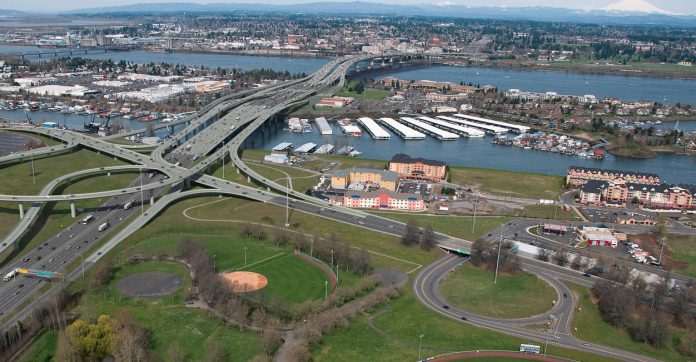For the second time this century, the states of Washington and Oregon are gearing up to attempt to replace the I-5 bridge over the Columbia river between the two states. The current set of two bridges, one built in 1917 and the other in 1958, has “significant seismic vulnerabilities,” but a previous plan to replace the bridge ended in 2013 when the Washington state legislature failed to include the project in a transportation funding package.
That iteration, called the Columbia River Crossing, was pegged at $3.4 billion and with such a high price tag because the project wasn’t simply a one-for-one replacement, but a doubling of the highway with numerous new interchanges, as well as funding for light rail from Portland to its fast-growing suburb Vancouver, a haven for those seeking to avoid Oregon’s income tax while still living close enough to take advantage of its lack of sales tax. Vancouver is the county seat of Clark County, which has seen its population more than double since 1990, when it was just 238,053 to today when it’s approaching 500,000 residents.
Opponents of the bridge, often at odds with each other, included light rail opponents like then-state senator and later Trump staffer Don Benton, and environmental advocates opposed to highway expansion. It was largely the price tag and lack of desire in Clark County for light rail, though, that caused the project to meet a dead end, with many high profile regional environmental groups staying out of the fight yet cheering its demise.
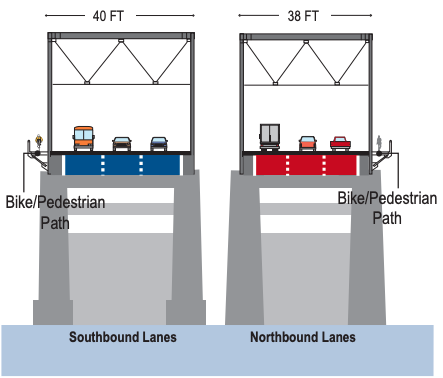
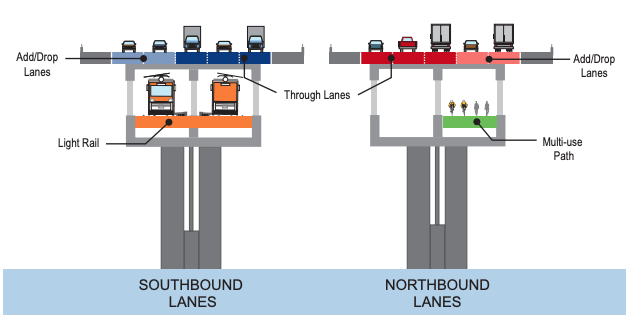
The design of the CRC would have taken the current six lanes of I-5 between the states to ten lanes plus four shoulders, and “optimized” seven interchanges on either side of the river. A full 40% of the cost of the project would have been for those interchanges, significantly more than the 30% that would have been for the bridges themselves, showing how much highway expansion was included in the CRC under the guise of replacing aging infrastructure.
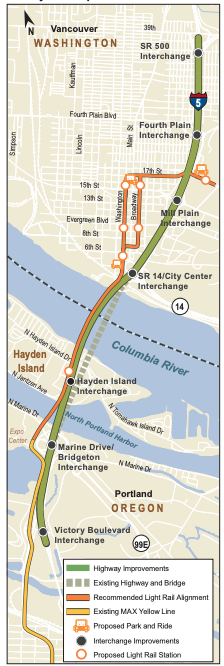
Last autumn, following legislative moves on the Washington side in 2017 to restart planning and a funding allocation matched by Oregon in early 2019, Washington Governor Jay Inslee and Oregon Governor Kate Brown signed a Memorandum of Intent to resurrect the project. The memo specifically notes that “the project office shall assume any plan for a new bridge will include high capacity transit”–notable because light rail was a big reason that the CRC met so much opposition in Clark County.
Last week, members of the legislatures of both states held a committee meeting to get an update on the project, where they were told that absent a significant increase in federal funding for the project, each state’s unfunded share of the project could end up being an additional $750 million to $1 billion. They were shown early cost estimates ranging from $3.17 billion to $4.81 billion for the entire project. Those numbers should be taken with a boulder of salt at this point, though.
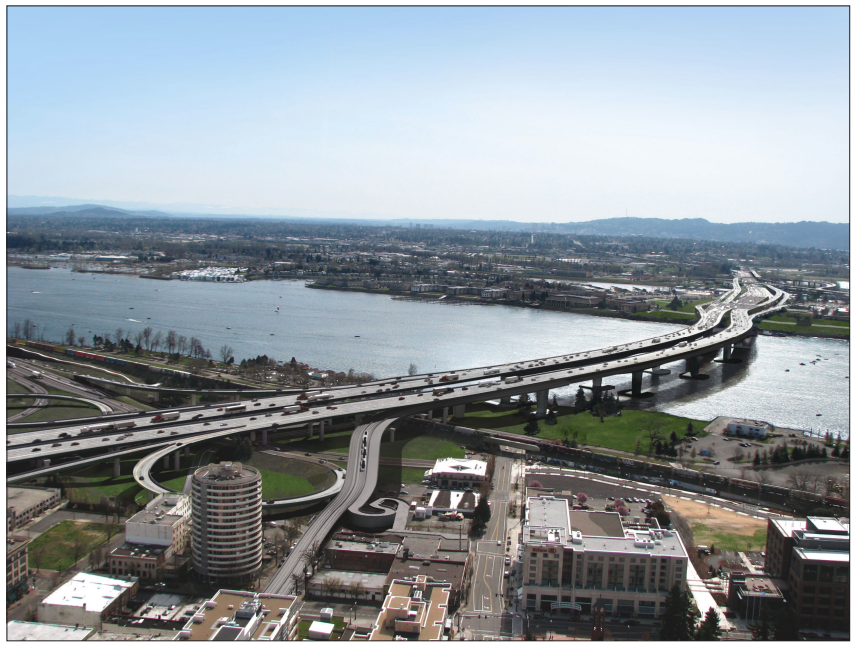
The project manager, Greg Johnson, who has a long resume in nationwide bridge projects, told the committee that the new project isn’t CRC 2.0, using the new name: Interstate Bridge Replacement (IBR) program. Yet those cost estimates are based on the old project, because there aren’t any concepts to estimate costs for on the IBR project. It was Washington State Representative Jake Fey, chair of the house transportation committee, who was so eager to get that price tag for each state’s share to include in a possible state transportation package in this upcoming legislative session. More accurate cost estimates aren’t expected for another year.
Clearly the need to distinguish this project as a clean slate stems from the reasons for the CRC’s demise. Yet the agencies will clearly be looking for any elements they can salvage from the previous planning process, and have said as much. When asked by a legislator if they might be able to speed up the process to take advantage of a federal infrastructure package expected in 2021, Johnson was clear that the entire environmental review process was being completed again, with no corners cut. “If we do cut corners, the people who are adverse to this will be there to knock us back to square one,” he said.
The Washington State Department of Transportation (WSDOT) apparently already has nearly $100 million ready for one of the interchange expansions in the CRC, at Mill Plain Boulevard in Vancouver, allocated from a 2015 transportation funding measure. This certainly makes it look like WSDOT assumes many of the elements of the CRC are set to return with the IBR project. WSDOT has funding for an element of the project that it’s currently telling the public doesn’t exist yet.
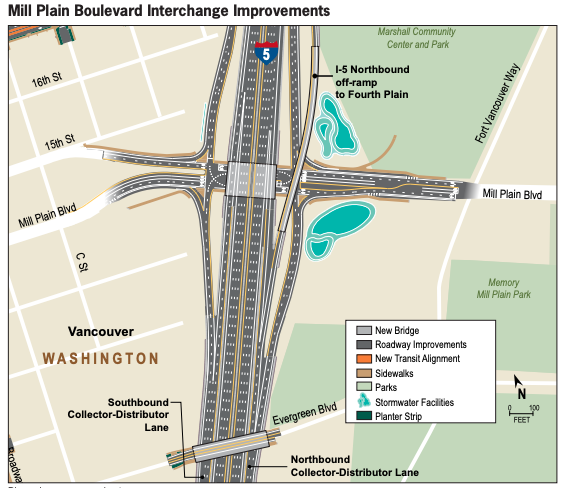
A surprisingly low proportion of the vehicle trips across the Columbia on I-5 are not using any of those interchanges: only 25% for southbound traffic and 32% for northbound. This explains the heavy focus for the project on those interchanges, but also underlines how much of the traffic driving the highway expansion, which will be discussed as a “nationally important” chokepoint, is local and suitable to be addressed through other transportation demand management options, including transit and tolls.
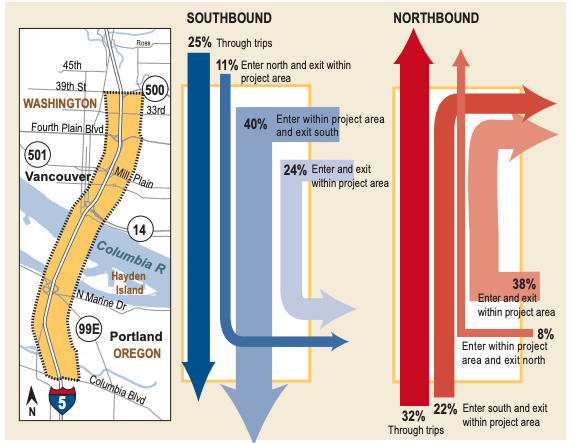
Tolls were always part of the CRC project, despite sharp opposition from the Washington side to tolling I-5. Oregon is moving forward with tolling I-205, another route between the two states in the Portland metro. A 2010 tolling study showed that tolling both I-205 and I-5 would reduce trips across the river by 23-27% depending on the rate of toll. Tolling, which is absolutely going to be considered again as part of the funding structure, weakens the argument for expansion even further.
The Oregon Department of Transportation’s director, Kris Strickler, served as the director of the entire Columbia River Crossing project from 2011 to 2014 and as deputy director of the project before that, most recently serving as a WSDOT Regional Administrator. He’s had the job for just over a year now, and during his confirmation he connected the idea of relieving congestion to reduced emissions. “Because we know that, cars sitting in traffic, emitting the emissions is not necessarily the best way to manage greenhouse gas reductions,” he told an Oregon State Senate Committee. His view on that lines up with that of the highway building lobby, but not the data. The idea that widening roads lowers emissions because of decreased idling has been thoroughly debunked.
What’s the impetus to re-start the project now? The state transportation agencies have long maintained that if they do not utilize $140 million in federal dollars by 2025, they will have to repay that amount. This has created a sense of urgency that others argue is false: Joe Cortright at Portland’s City Observatory maintains that Federal Highway Administration doesn’t require repayment of dollars if the agencies complete their environmental review and select a “no build” option. That didn’t happen with the CRC project, but it could happen this time. As for right now, the agencies are fixated on getting a Federal Record of Decision for the project by mid-2023.
That means 2021 will be a pivotal year for those watching the project to ensure that the worst elements of the CRC aren’t locked in again. Right now, the project office is convening both a Community Advisory Group and an Equity Advisory Group, which will be providing input to update the stated purpose of the project, and what needs it’s addressing, as well as the vision and values that go along with it. That will make up the first half of next year, with the second half devoted to looking at project alternatives that come from that. Once that happens, the environmental review will get underway with a Locally Preferred Alternative (LPA) set to be presented in 2022.
Early next year, the project will get its own website and outreach will begin in earnest, and we will be following this megaproject very closely as that happens. You can sign up for emails about the project on WSDOT’s website.
Ryan Packer lives in the Summit Slope neighborhood of Capitol Hill and has been writing for the The Urbanist since 2015. They report on multimodal transportation issues, #VisionZero, preservation, and local politics. They believe in using Seattle's history to help attain the vibrant, diverse city that we all wish to inhabit. Ryan's writing has appeared in Capitol Hill Seattle Blog, Bike Portland, and Seattle Bike Blog, where they also did a four-month stint as temporary editor.


